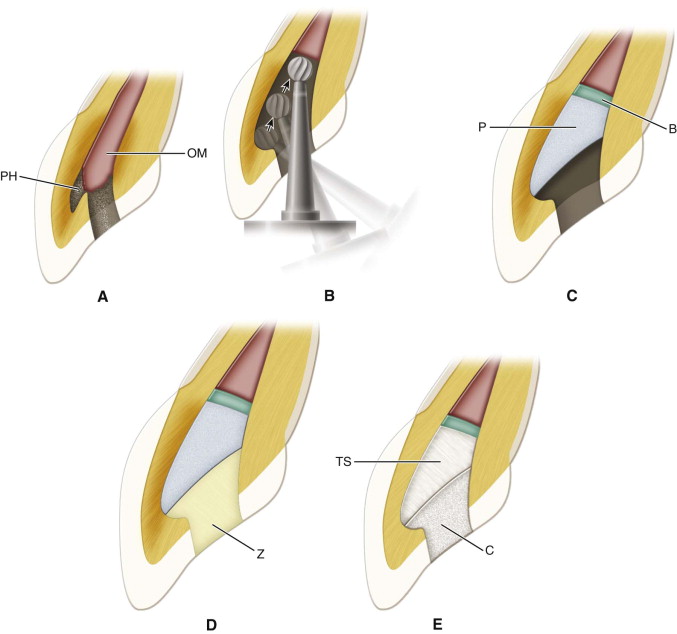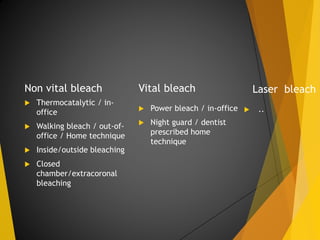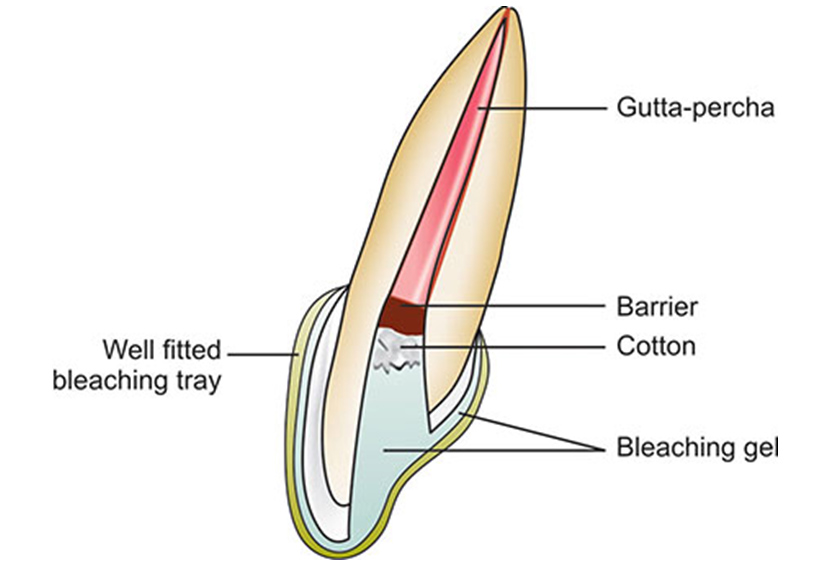walking bleach technique
Together to bleach endodontically treated anterior teeth using the walking bleach method described below. All teeth received traditional biomechanical root canal instrumentation after which the walking bleach agent was placed in the pulp chamber space.

Walking Bleach Lee Ann Brady Dmd
Agents used for Walking Bleach Technique 26.

. Hydrogen peroxide and sodium perborate are commonly used bleaching. The tooth involved is usually non vital and should be endodontically treated. Before the placement of bleaching gel Opalescence Endo into the tooth the so-called pulp chamber.
Initial tooth color using an appropriate shade guide is documented. 1989-11-01 000000 METHOD For optimum results the following technique should be adhered to. Ambulatory techniques when high concentrations of hydrogen peroxide and carbamide peroxide are used require different types of sources for gel activation such as light heat or laser.
Nonvital bleaching was performed with a walking bleaching technique consisting of four sessions of bleach application. A number of techniques have been developed to manage the problem of a single pulpless discoloured tooth. The walking bleach technique is used to whiten teeth that have had root canal treatments.
Walking Bleach Technique The process should not be repeated four more than four weeks to avoid weakening of the crown and potential spontaneous fracture 25. In preparation for the walking bleach method a rubber dam was placed and the access cavity was re-opened. It has been established that 30 hydrogen peroxide alone or in combination with sodium perborate are more cytotoxic for periodontal cells than perborate-water mixture.
This method was later modified by replacing water with 30. Generally a paste of sodium perborate mixed with either hydrogen peroxide or water is sealed in the pulp chamber by a temporary restoration and changed every 3 to 7 days until tbe desirable sbade re-. However sodium perborate has been classified as carcinogenic mutagenic and toxic for reproduction by European Union legislation.
The purpose of this study was to compare the in vitro sealing capacity of five materials each used as a temporary sealing agent for the walking bleach technique. INDICATIONS Indicated for bleaching or whitening discolored endodontically treated anterior teeth. It involves bleaching the tooth from the inside of the tooth.
This a reliable and efficient technique of internal beaching which does not require the patient sit for too long a time in the dental chair. Thermocatalytic and walking bleach. Lado et al presumed.
The walking bleach technique i. CONTRAINDICATIONS This product should not be used with individuals with known sensitivities to hydrogen peroxide or sodium perborate. Management of intrinsic discoloration using walking bleach technique in maxillary central incisors Clujul Med.
Different radicals or ions are generated from H 2 O 2 which have the ability to crack the unsaturated double bonds of long coloured molecules or reduce the coloured metallic oxides. Opalescence Endo non-vital whitening gel is formulated specifically to whiten endodontically treated discoloured teeth using the walking bleach technique. Internal bleaching procedures such as the walking bleach technique can be used for whitening of discoloured root-filled teeth.
Whitening of nonvital endodontically treated teeth by walking bleach technique is a time-consuming procedure which requires multiple visits. The anterior dentitions are photographed using a Polaroid CU5 camera. Gingival crevicular fluid samples were taken in order to quantify the RANK-L and IL-1β levels by enzyme-linked immunosorbent assay.
After the cleaning procedure the. Sodium perborate mixture decomposes to release H 2 O 2. All restorative and root sealing material was removed from the coronal pulp chamber and 2 - 3 mm below the healthy gingiva a.
Walking bleach technique has proven to be a successful method in management of such cases. Both methods have lost favor due to the potential risk which includes cervical resorption under- or over-lightening the possibility of color regression and external root resorption. Diagnosis An accurate diagnosis allows the formulation of the optimal treatment plan.
In order to establish the. The cavity was cleaned thoroughly in order not to compromise the whitening result. The reason for resorption of bleached teeth have not yet been successfully understood.
At our office todays widely used internal bleaching technique known as walking bleach is applied. Non-vital bleaching is a non-invasive technique to treat the intrinsic discoloration of teeth of several etiologies. The walking bleach technique that was introduced in 1961 involved placement of a mixture of sodium perborate and water into the pulp chamber which was sealed into place between dental visits.
Two basic techniques have been used to bleach discolored nonvital teeth. Recently a variety of products and techniques have. 1-Sodium Perborate Available as powder that is stable when dry It is an oxidizing agent It is mixed with water or with.
Root canal treatments may discolour teeth due to the materials used to fill the root canal discolouration breakdown of blood in the root canal and medications used in the root canal during the. Three vestibular and. Over the past decades the walking bleach technique using sodium perborate was considered a safe and effective method to bleach nonvital discolored teeth.
The most popular bleaching technique is the walk-ing bleach technique in which many bleaching agents have been used. The aim of this paper is to discuss inside outside bleaching and to compare the merits and problems of different techniques. Samples were obtained from six periodontal sites for each bleached tooth.
Easy to place. Once Opalescence Endo gel is delivered to the pulp chamber it should be sealed with a temporary cement and left in the tooth for one to five days. Its use is therefore prohibited since April 2015.
Walking bleach is a bleaching procedure performed at a dental clinic. Petroleum jelly is applied to. Enamel surface is polished with polishing paste.
The Walking Bleach Technique The Walking Bleach Technique Putter Harvey. The walking bleach technique.
Clinical Research Dental Ultradent Opalescence Endo Whitening

Bleaching Procedures Pocket Dentistry

Bleaching Discolored Teeth Pocket Dentistry
Intracoronal Bleaching Of Nonvital Tooth Teeth Whitening

Pdf The Efficacy Of Walking Bleach Technique In Endodontically Treated Teeth Case Report

Non Vital Internal Bleaching Prestige Dental Care Com My

Unilite Endo Non Vital Bleaching

Walking Bleach Lee Ann Brady Dmd

Internal Endodontics Walking Bleach Youtube

Pdf Esthetic Correction Of Calcified Tooth Discoloration By Walking Bleach Technique Semantic Scholar

Intracoronal Bleaching Of Nonvital Teeth Pocket Dentistry

Tooth Discoloration Classification Of Discoloration Intrinsic Discoloration Extrinsic

An Effective Bleaching Technique For Non Vital Discoloured Teeth In Children And Adolescents Semantic Scholar

An Effective Bleaching Technique For Non Vital Discoloured Teeth In Children And Adolescents Semantic Scholar

Amalgam And Composite Restorations Ppt Video Online Download




Comments
Post a Comment